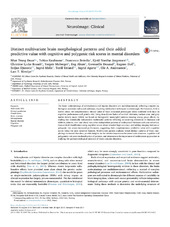| dc.contributor.author | Doan, Nhat Trung | en_US |
| dc.contributor.author | Kaufmann, Tobias | en_US |
| dc.contributor.author | Bettella, Francesco | en_US |
| dc.contributor.author | Jørgensen, Kjetil Nordbø | en_US |
| dc.contributor.author | Brandt, Christine Lycke | en_US |
| dc.contributor.author | Moberget, Torgeir | en_US |
| dc.contributor.author | Alnæs, Dag | en_US |
| dc.contributor.author | Douaud, Gwenaëlle | en_US |
| dc.contributor.author | Duff, Eugene | en_US |
| dc.contributor.author | Djurovic, Srdjan | en_US |
| dc.contributor.author | Melle, Ingrid | en_US |
| dc.contributor.author | Ueland, Torill | en_US |
| dc.contributor.author | Agartz, Ingrid | en_US |
| dc.contributor.author | Andreassen, Ole Andreas | en_US |
| dc.contributor.author | Westlye, Lars Tjelta | en_US |
| dc.date.accessioned | 2019-03-28T16:25:06Z | |
| dc.date.available | 2019-03-28T16:25:06Z | |
| dc.date.issued | 2017-06-09 | |
| dc.Published | Doan NT, Kaufmann T, Bettella F, Jørgensen Kn, Brandt CL, Moberget T, Alnæs D, et al. Distinct multivariate brain morphological patterns and their added predictive value with cognitive and polygenic risk scores in mental disorders. NeuroImage: Clinical. 2017;15:719-731 | eng |
| dc.identifier.issn | 2213-1582 | |
| dc.identifier.uri | https://hdl.handle.net/1956/19251 | |
| dc.description.abstract | The brain underpinnings of schizophrenia and bipolar disorders are multidimensional, reflecting complex pathological processes and causal pathways, requiring multivariate techniques to disentangle. Furthermore, little is known about the complementary clinical value of brain structural phenotypes when combined with data on cognitive performance and genetic risk. Using data-driven fusion of cortical thickness, surface area, and gray matter density maps (GMD), we found six biologically meaningful patterns showing strong group effects, including four statistically independent multimodal patterns reflecting co-occurring alterations in thickness and GMD in patients, over and above two other independent patterns of widespread thickness and area reduction. Case-control classification using cognitive scores alone revealed high accuracy, and adding imaging features or polygenic risk scores increased performance, suggesting their complementary predictive value with cognitive scores being the most sensitive features. Multivariate pattern analyses reveal distinct patterns of brain morphology in mental disorders, provide insights on the relative importance between brain structure, cognitive and polygenetic risk score in classification of patients, and demonstrate the importance of multivariate approaches in studying the pathophysiological substrate of these complex disorders. | en_US |
| dc.language.iso | eng | eng |
| dc.publisher | Elsevier | eng |
| dc.rights | Attribution CC BY-NC-ND | eng |
| dc.rights.uri | http://creativecommons.org/licenses/by-nc-nd/4.0/ | eng |
| dc.subject | Multimodal MRI | eng |
| dc.subject | Clinical prediction | eng |
| dc.subject | Classification | eng |
| dc.subject | Brain structure | eng |
| dc.subject | Schizophrenia | eng |
| dc.subject | Bipolar disorder | eng |
| dc.subject | Cognition | eng |
| dc.subject | Polygenic risk | eng |
| dc.title | Distinct multivariate brain morphological patterns and their added predictive value with cognitive and polygenic risk scores in mental disorders | en_US |
| dc.type | Peer reviewed | |
| dc.type | Journal article | |
| dc.date.updated | 2018-02-12T10:21:33Z | |
| dc.description.version | publishedVersion | en_US |
| dc.rights.holder | Copyright 2017 The Authors | |
| dc.identifier.doi | https://doi.org/10.1016/j.nicl.2017.06.014 | |
| dc.identifier.cristin | 1498835 | |
| dc.source.journal | NeuroImage: Clinical | |
| dc.relation.project | Helse Sør-Øst RHF: 2014097 | |
| dc.relation.project | Norges forskningsråd: 249795 | |

